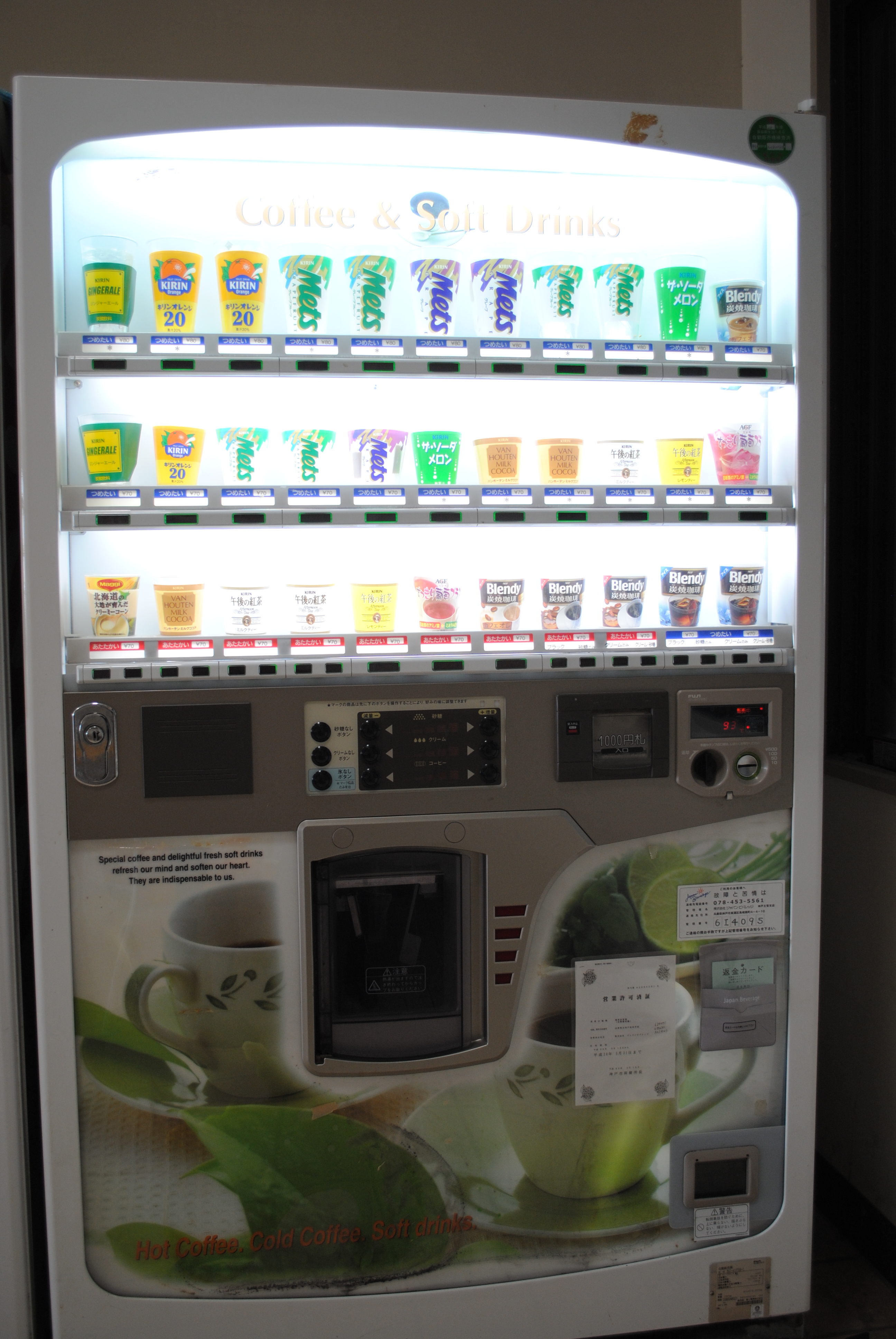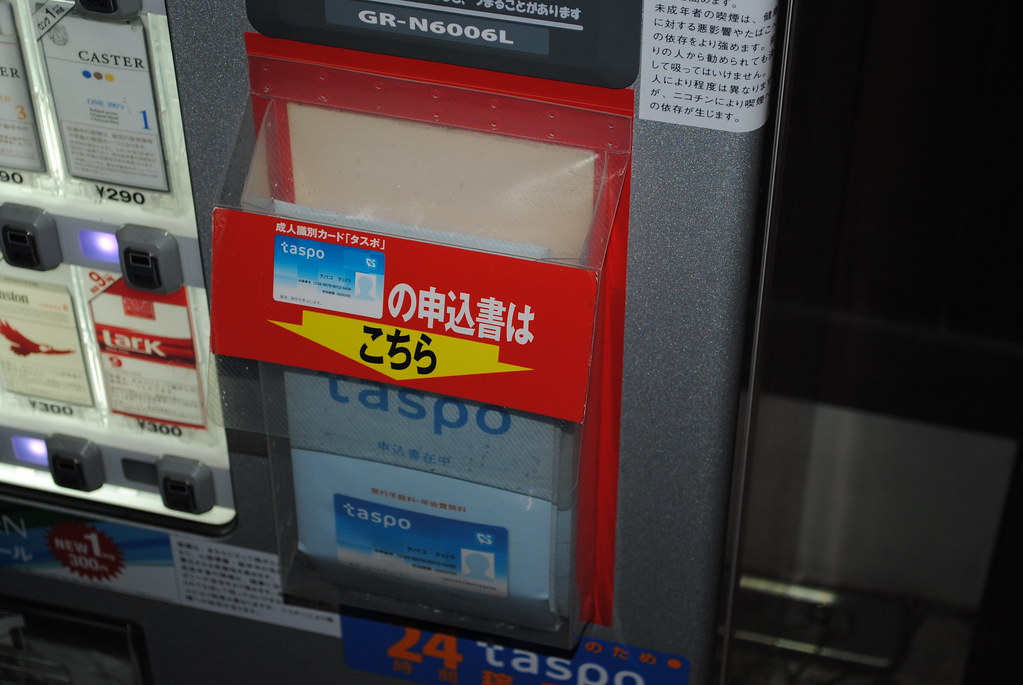自動販売機 (or sometimes just 販売機 - はんばいき - hanbaiki) literally means "automatic selling machine" and will probably be one of the longest Japanese words you learn. They've become a bit of a symbol of Japan and if you come to visit, you'll see why. You'll notice that there are a lot of them to say the least - the most of any country in the world, in fact. There's apparently one vending machine for every 23 people here (and the population is about 130 million). It's rumoured that they even have them on top of 富士山 (Fujisan - Mount Fuji)!
Let's have a closer look at a couple of our 5.5 million friends and see why they're so popular.
This is a typical example of a 自動販売機. Unlike vending machines in Australia, it serves both hot and cold drinks. The hot ones are indicated by the red stripe below them and the cold ones by the blue. If you click on the photo and have a closer look (I've posted a really big one this time so you can see), you should be able to spot what's written on these stripes - "あたたかい" (atatakai - warm) on the red one and "つめたい" (tsumetai - cold) on the blue one. You may be more used to the word "寒い" (さむい - samui) for "cold", but this is only used when describing the weather. つめたい is used for describing cold things - make sure not to mix them up! Occasionally they just say "ホット" (hotto - hot) or "アイス" (aisu - ice) which makes things even easier.
The most common things you see in vending machines are in the photo as well. In the top row on the left, we have bottles of cold green tea, then lemon tea, milk tea and cold cans of coffee. Next row down, there are a variety of different cans of hot coffee, hot milk tea and ココア (kokoa - cocoa. Don't forget to pronounce the "a" sound at the end!). The left side of the 3rd row has smaller bottles of the other cold drinks, Kirin cola, drinking yoghurt and fruit juice. The right side has smaller hot teas, and on the far right, コーンポタージュ (koon potaaju - corn soup). It may seem very odd to drink soup out of a ringpull can, but make sure to give it a try if you get the chance!
During winter, hot cans of coffee and soup are a very welcome break from the weather. They're not hot enough to burn your hands, but will definitely keep your fingers (and face) warm for a few minutes. 自動販売機 coffee tends to be very sweet and milky because it often contains condensed milk. カフェオレ (kafe o re - cafe au lait) usually has cream in it as well. The ones that say "black" like in the photo are the exception - they're quite literally black coffee with no sugar. Otherwise, assume the coffee you buy is going to be milky and sweet. BOSS Coffee and Kirin are probably the most common brands you see.
The word ティー (tii - "tea") usually means 紅茶 (こうちゃ - koucha - black tea similar to what we would drink at home) in the form of ミルクティー (miruku tii - milk tea) which is also sweet and milky. It's also sometimes called ロイヤルミルクティー (roiyaru miruku tii - royal milk tea) or 午後の紅茶 (ごごのこうちゃ - gogo no koucha - "Afternoon Tea" in the top right of the machine). It usually has a picture of a crown, a teacup or a lady in a fancy hat to indicate that it's "Western-style" tea. The hot ones usually come in a plastic bottle rather than a can, which means they hold their heat for a shorter time. Western-style flavoured ice tea is becoming more popular, and there are lots of variations of Japanese tea available too. What we would call "green tea" is broadly called お茶 (おちゃ - ocha), but more specifically it's called 生茶 (なまちゃ - namacha - literally "raw tea", in the top left of the machine) or 煎茶 (せんちゃ - sencha). Other common varieties are 麦茶 (むぎちゃ - mugicha - barley tea) and ウーロン茶 (uuroncha - oolong tea). None of these Japanese teas have milk in them and they're very rarely sweetened so they're a good option if you're a bit sugared out.
Another common form of 自動販売機 is this one - it fills you up a cup rather than a can. As you can see by the prices, these ones tend to be a bit cheaper but the cups are open at the top so they're less portable. Have a look at the photo and see if you can work out what everything is. I particularly recommend the メロンソーダ (meron sooda - melon soda) if you see it - be adventurous!
All of these are referred to as 飲み物 (のみもの - nomimono) or ドリンク (dorinku), both meaning "drinks". That's not all that's sold at 自動販売機, however. They also commonly sell hot meals, instant noodles, snack foods, tickets and even cigarettes and alcohol. I remember thinking this was unusual and sure enough, a new photo ID system called "Taspo" (short for たばこパスポート - tabako pasupooto - tobacco passport) was introduced recently to stop underaged people buying cigarettes like this.
The Taspo needs to be held up to the machine before it will dispense the cigarettes and only people over 20 (the adult age in Japan) can apply for one. There isn't a similar system for alcoholic vending machines yet, but I don't think it's too far away.
自動販売機 have become such a natural part of the landscape in Japan that something seems very off when there aren't any around. In temples, on top of mountains, in the middle of nowhere - nothing seems to be too out of the way. The next time you're in Japan freezing during winter or sweating through summer, rest assured that you're never more than a block or two from canned comfort.
Japanese culture, life and language (without the boring bits) from a Western Australian teacher on the inside. For teachers and students of Japanese (don't tell them it's educational).
Search This Blog
Monday, March 1, 2010
自動販売機 (じどうはんばいき - jidouhanbaiki) - Vending machines
Labels:
coffee,
daily life,
drinks,
language,
tea,
vending machine
Subscribe to:
Post Comments (Atom)



Hi Mike, this blog is fantastic! You reminded me of a time when I climbed Mt Fuji overnight about 14 years ago. I had an instant recall of huffing and puffing and finally reaching a station about halfway when suddenly we came across a small vending machine.... full of oxygen cans LOL. I didn't have the right change but I managed to reach the top regardless :-) Cheers Penny
ReplyDeleteWow, I definitely hadn't heard of vending machine O2 before! We're planning to climb Fuji later in the year so we'll have to keep an eye out for them. Hopefully we won't need them either though!
ReplyDeleteThanks for the positive feedback as well, I appreciate it.